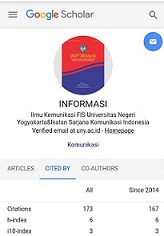HUBUNGAN KERJA DALAM INDUSTRI FAST FASHION: ANALISIS ISI TERHADAP FENOMENA EKSPLOITASI (STUDI KASUS FILM THE TRUE COST DAN NIKE SWEATSHOPS)
DOI:
https://doi.org/10.21831/informasi.v46i1.9647Keywords:
Labor Relations, Fast-fashion, Content AnalysisAbstract
The fast-fashion industry is one of the manufacturing industry that is associated with the developing countries as a producer of their products. Authors carriying an issue of labor relations in the fast-fashion industry which is very important to be studied due to exploitation issues. The main focus of the study is to assess the film "The True Cost" which describes the fast-fashion industry in Bangladesh and "Nike Sweatshops" which describes the fast-fashion industry in Indonesia. This study sought to answer whetherthe exploitation occurs in fast-fashion industry are presented in the movie "The True Cost" and "Nike Sweatshops" and how the mechanism of the exploitation is working. By using the content analysis method, it was found that in both films the exploitation did occur, but both films have similarities and differences of the dominant aspects of exploitation based on wages, health insurance, safety insurance, time, physical violence and the formation of unions. In addition besides the findings of the movie, the context of the economic, social, and political in certain periods and employment policies contribute to the occurrence of labor exploitation
Industri fast-fashion merupakan salah satu jenis industri manufaktur yang tidak terlepas kaitannya dengan negara-negara berkembang sebagai penghasil produknya. Penulis mengangkat sebuah isu tentang hubungan kerja di dalam industri fast-fashion yang sangat penting untuk dikaji karena maraknya isu eksploitasi.Fokus utama penelitian adalah mengkaji film "The True Cost" yang menggambarkan industri fast fashion di Bangladesh dan "Nike Sweatshops" yang menggambarkan industri fast fashion di Indonesia. Penelitian ini berusaha untuk menjawab apakah eksploitasi terjadi pada industri fast-fashion yang disajikan dalam film "The True Cost" dan "Nike Sweatshops"serta bagaimana mekanisme eksploitasi tersebut bekerja. Dengan menggunakan menggunakan metode analisis isi, didapati bahwa dalam kedua film ini eksploitasi memang terjadi namun kedua film ini memiliki kesamaan dan perbedaan
dari aspekdominan eksploitasi berdasarkan upah, jaminan kesehatan, jaminan keselamatan, waktu, kekerasan fisik dan pembentukan serikat. Selain temuan dari film tesebut, didapati bahwa konteks ekonomi, sosial, dan politik pada periode tertentu serta kebijakan ketenagakerjaan turut mendukung terjadinya eksploitasi tenaga kerja.
References
Aloewie, Tjepi F. 1996. Naskah Akademis Tentang Pemutusan Hubungan Kerja dan Penyelesaian Perselisihan Industrial, Cetakan ke-11, BPHN, Jakarta
Bhardwaj, Vertica and Ann Fairhurst. 2010. The International Review of Retail, Distribution and Consumer Research Vol. 20, No. 1, February 2010, 165–173
Fletcher, K. 2008. Sustainable Fashion & Textiles: Design Journeys. Oxford: Earthscan
Herawati, Rina. 2010. Kontrak dan Outsourcing Harus Makin Diwaspadai. Seri Buku Saku Akatiga. Akatiga-FES
Joy, Annamma Joy, John F. Sherry, Jr, Alladi Venkatesh, Jeff Wang and Ricky Chan. 2012. Sustainability, and the Ethical Appeal of Luxury Brands. Fashion Theory, Volume 16, Issue 3, pp. 273–296 DOI:10.2752/175174112X13340749707123
Kohli, Saket. 2013. Offshore Outsourcing and Ethics: An Example of Apparel Manufacturing Industry of Bangladesh. Otago Management Graduate Review Volume 11 2013
Lavergne, Michael. 2015. Fixing Fashion: Rethinking the Way We Make, Market and Buy Our Clothes. New Society Publishers
Marvasti, Amit B. 2004. Qualitative Research in Sociology. Sage Publication
Quelch,John A. and Margareth Rodriguez. 2013. Rana Plaza: The Bangladesh Garment Tragedy (A). Harvard Bussines School
Ritzer, George & Douglas J. Goodman. 2008. Teori Sosiologi, Bantul : Kreasi Wacana
Tambunan, Tulus. 2006. Perkembangan Industri Dan Kebijakan Industrialisasi Di Indonesia Sejak Orde Baru Hingga Pasca Krisis. Kadin Indonesia-JETRO
Zwolinsky Matt, 2007. Business Ethics Quarterly, Volume 17, Issue 4.
International Labour Organization. 2014. Wages and Working Hours in the Textiles, Clothing, Leather and Footwear Industries
Ketetapan Majelis Permusyawaratan Rakyat Republik Indonesia Nomor XVII/ MPR/1998 Tentang Hak Asasi Manusia
Undang-Undang No 13 Tahun 2003 Tentang Ketenagakerjaan Republik Indonesia.
Are your clothes made in Sweatshops? https://www. oxfam. org. au/what- we-do/ethical-trading-and business/ workers-rights/are-your-clothes- made-in-Sweatshops/
Drennan, Kelly. 2015. How the Fashion Industry is Picking Up the Threads After Rana Plaza http://www. alternativesjournal. ca/policy-and-politics/how-fashion- industry-picking-threads-after-rana- plaza
United States General Accounting Office. 1994. Garment Industry Efforts To Address The Prevalence And Conditions Of Sweatshopss. Report to the Chairman, Subcommittee on Commerce, Consumer and Monetary Affairs, Committee on Government Operations, House of Representative
Wawancara Dita Indah Sari: "Saya Tidak Bersalah, Mengapa Harus Minta Grasi?" http://tempo. co. id/ang/min/02/20/ nas2.html
When Will Nike "Just Do It" On The Sweatshops Issue? http://www. huffingtonpost. com/jim-keady/when- will-nike-just-do-it_b_308448. html
World Trade Organization. 2014. International Trade Statistics.
Keady, Jim. 2000. Nike Sweatshops: Behind The Swoosh. Teamsweat. org (in association with) Educating For Justice.
Morgan, Andrew. 2015. The True Cost. Life Is My Movie Entertainment Company (in association with) Untold Creative
Downloads
Published
Issue
Section
License
Authors who publish with this journal agree to the following terms:- Authors retain copyright and grant the journal right of first publication with the work simultaneously licensed under a Creative Commons Attribution License that allows others to share the work with an acknowledgement of the work's authorship and initial publication in this journal.
- Authors are able to enter into separate, additional contractual arrangements for the non-exclusive distribution of the journal's published version of the work (e.g., post it to an institutional repository or publish it in a book), with an acknowledgement of its initial publication in this journal.
- Authors are permitted and encouraged to post their work online (e.g., in institutional repositories or on their website) prior to and during the submission process, as it can lead to productive exchanges, as well as earlier and greater citation of published work (See The Effect of Open Access).





















